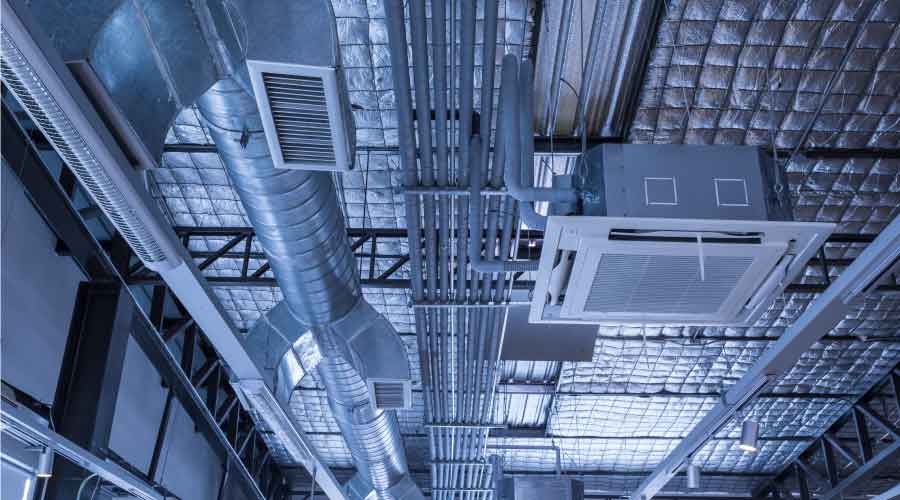How Relative Humidity and Filtration Innovation Produce Good IAQ
Innovations in the HVAC industry are helping buildings maintain optimal comfort and safety levels for building occupants.
By Christopher Roman, contributing writer
We have all heard the weatherman on TV say, “There is going to be high humidity today,” but what does that actually mean? More specifically, what does that mean to the buildings we manage every day? And how can precision humidity control help increase building comfort while also providing a safer environment to breathe? To answer these questions, we’ll need to focus on relative humidity (RH), HVAC and filtration innovations, and what health benefits are associated with these innovations in a post-pandemic world.
Humidity is the amount of water vapor present in the air expressed as a percentage. When RH is at 100 percent outside, obviously it is raining. When RH is at 10 percent outside the environment is very dry. But where do we need to keep the RH values inside of a building? The general design parameters of RH control are between 40 and 60 percent. This range is designated as “comfort zone” for humans. When HVAC systems have a difficult time meeting these parameters, this introduces unnecessary risk into buildings.
What happens to a building’s indoor air quality when temperature or RH values are not met? Basically, a facility’s indoor air quality will drop quickly if the RH values are allowed to fluctuate outside these boundaries. The more fluctuation, or the more hours per year a building operates outside of these parameters, the more likely there will be IAQ issues and unnecessary business model risk.
The coronavirus pandemic also forced the HVAC industry to become more creative and innovative in two main areas. Overall HVAC air handling unit (AHU) design and optimizing off the shelf filtration. The end result is, the two innovations in combination become a very powerful tool for building owners and facility managers to increase their IAQ, save anergy annually, and reduce their overall risk of facility management.
To combat the growth and spread of viruses, bacteria, and other pathogens the traditional AHU design has to be altered. The first innovative design change is the maximization of coil surface area. Traditional HVAC AHU designs use small four or six row coils. These coils allow the heat to be removed from the building. Naturally, the more rows of coils there are, the more heat can be removed more efficiently. This process dries the air out and allows any moisture in the air to be properly captured and removed from the facility safely.
Using larger 10-row coils allows for more precision in efficiently obtaining RH goals of 40 to 60 percent. However, larger coils are just the start. It is also advantageous to slow down the face velocity of air through the system. Traditional design AHU face velocity is around 450 to 550 feet per minute (fpm). Newer innovative designs are using face velocities from 250 to 350 fpm. This allows the air to slow down through the unit and spend more contact time with the larger coils that are working hard to dehumidify the air. A traditional four- to six-row coil design at 500 fpm blows across the coil in 0.06 to 0.09 seconds which is much faster than a blink of an eye (.30 seconds).
When air is slowed down through the system and the coil size is increased, the system improves. There is now the opportunity for fan savings, compressor savings, pumping savings and higher IAQ inside the building. It is a rare feat to have all of these things happen on the same project.
Larger coils do come with potential diminishing returns. If you have too large of coils (12 or more rows), a high fin per inch, or your cooling coils are too tall, you cannot clean the coils properly and you will also create “condensate stacking.” Condensate stacking is the process in which the moisture on the cooling coil cannot drain properly into the drain pain so the water blocks the airflow path. Condensate stacking reduces the useable cooling coil heat transfer surface area, which defeats the purpose of having larger coils. Condensate stacking also increases the face velocity of the unit from its design parameters because the air has to travel around the stacking which provides a smaller tunnel in which the air can flow. This process reduces the contact time with the larger coils, reducing the overall value of the coil while providing an environment where bacteria and other organic materials can thrive.
The second AHU innovative design change is the maximization of “off the shelf filtration.” To maximize the filtration in an AHU, a pre-filter system and after-filter system are needed. The pre-filter system needs to be a set of two filters. The first filter is typically a Minimum Efficiency Rating Value (MERV) of 8 to 11. The second filter in the pre-filter system is a MERV 16, or in some cases a HEPA filter. The reason for the two filters is to remove the “filter loading” on the filter that is able to do more filtering. In this case the MERV 16 can now filter more, finer, particles because the MERV 8, or MERV 11, is capturing the larger particles up front allowing the MERV 16 filter to last longer, reducing maintenance times and costs.
The after-filter system uses the same premise except the level of filtration is raised due to the fact that the air is about to leave the AHU and enter into the breathable work space of a facility. Therefore, the first filter in the post-filter system is a MERV 16. This is the filter we ended with in the pre-filter system. The second filter in the post filter system, is a HEPA or ULPA filter which filters down to the lowest micron levels achievable.
This is where the innovative HVAC AHU design and the innovative filter systems power combines. According to a NASA study, filter efficiency is highly dependent on the velocity of the air in the system. The lower the air velocity, the more effective the high-end filters become. This also means that the innovative pre-filter systems and after-filter systems receive another “jump” in filter effectiveness.
There are always silver linings to the obstacles and challenges we face as a society and there have been many throughout history. However, the most recent challenge has pushed HVAC design to newer and better heights. As these innovations become more mainstream and more broadly accepted in facilities around the world, occupants will be happier and more productive.
Christopher Roman leads the strategic business development for Conservant Systems.
Related Topics:












